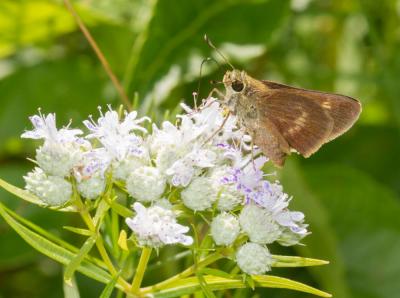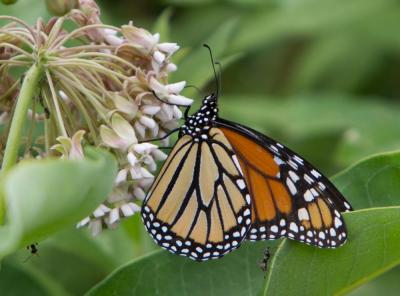Planning a garden? Think Butterflies!
So, you’re planning out your summer gardens, and would like to attract more butterflies to your yard? Several varieties of native plants should be considered.
Butterflies need two things to survive, their specific host plant on which their eggs are laid (and caterpillars feed on) and sources of nectar needed as adult butterflies for the fuel to survive. This nectar is found in most of our native wildflowers, either growing wild in nature, or planted in our yards.
The plant that we hear about most often when talking butterflies is common milkweed (Asclepias syriaca). This highly beneficial plant is the host plant for the monarch butterfly. They lay their eggs on the undersides of the leaves, the caterpillars feed on it, and before long we see the adult butterflies flying around the yard! The flowers of the common milkweed are also a great source of nectar for all butterflies from around mid-June and into July here on the south coast. After a couple weeks, the flowers will wither and die off. So what do you do now? There are several other plants that can be planted that will guarantee your gardens provide nectar throughout the season. As always, plan accordingly as some of these plants grow up high and some very low. The good thing is that most of them, being native and fully adapted to our area require little care for them to thrive!
Just a few of our favorites are listed below, but several sources of information can be found here: Butterfly Gardening
Violets - several varieties of violets give early season butterflies a source of nectar when other flowers aren’t yet blooming.
Butterfly weed (Asclepias tuberosa) - this type of milkweed typically blooms for a much longer period of time throughout the summer. It’s bright orange blooms attract several species of butterflies.
Mountain Mint (Pycnanthemum tenuifolium) - this is a great source of nectar for butterflies. Blooms will appear a little later in the season than milkweed, typically July and August.
New England Aster (Symphyotrichum novae-angliae) - these are perfect for a late season nectar source! Not only are they great for the native butterflies but can often help draw some of the migrant butterflies that we see here late in the summer and early fall into your yard.
Goldenrods (solidago speciosa and others) - these large yellow flower clusters attract all kinds of butterflies in late season (September and October) and offer a great nectar source for migrating monarchs as they head south for the winter.
Cone flower (Echinacea) - typically found in the purple variety, this great nectar source also comes in a variety of colors and blooms throughout the summer.
Coreopsis (several varieties) - The yellow, daisy-like flowers bloom throughout most of the summer and provide a nice nectar source for a full variety of butterflies.
Planting some of these in your gardens will certainly help draw in butterflies for your viewing enjoyment.
Want to learn more about butterflies? We run field trips throughout the summer all over Massachusetts. It costs nothing to join us on these walks. Check the list of all of our field trips here: Massachusetts Butterfly Field Trips and sign up for one today. Trips are added to the list on a regular basis, so continue to check back! Don’t think you know enough about butterflies for a field trip? We always encourage novice and more advanced butterfly enthusiasts on ALL of our trips. We are all continually learning. Let’s learn together!
Participants on our field trips are encouraged to bring water, bug repellant and any appropriate sun protection that may be needed during a 2+ hour walk.
















